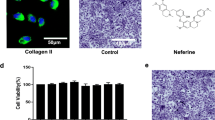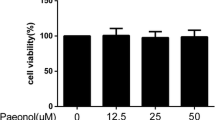Summary
In order to find new drugs to inhibit nitric oxide (NO) production, the effects of pyrrolidine dithiocarbamate (PDTC), a nuclear factor-kappa B (NF-κB) inhibitor, on recombinant human interleukin-1β (rhIL-1β)-induced NO production in chondrocytes were investigated. Rat chondrocytes were isolated and cultured, divided into control, P0, P1, P2, P3 and P4 groups. The chondrocytes in the P0, P1, P2, P3 and P4 groups were treated with different concentrations of PDTC (0, 3, 10, 30, and 50 μmol/L respectively) for 1 h and then incubated with 5 U/mL rhIL-1β for 24 h. NO assay kit and RT-PCR were used to detect the NO content and the iNOS mRNA expression in the chondrocytes. The expression level of iNOS mRNA in control, P0, P1, P2, P3 and P4 groups was 0.02±0.01, 1.24±0.13, 1.21±0.14, 0.61±0.11, 0.40±0.09, 0.21±0.06, and the relative content of NO was 15.8±2.7, 100±14.8, 92.6±9.3, 68.3±14.2, 27.5±9.8, 19.8±3.6, respectively. In the P0, P1, P2, P3 and P4 groups, the expression of iNOS mRNA and NO production were significantly increased as compared with those in the control group. As compared with the P0 group, the expression of iNOS mRNA and NO content in control group were lower. In the P2, P3 and P4 groups, PDTC could significantly inhibit the expression of iNOS and NO production induced by rhIL-1β in a concentration-dependent manner. It is suggested that PDTC can inhibit NO production and iNOS mRNA expression induced by IL-1β, which may provide an alternative method for the treatment of osteoarthritis.
Similar content being viewed by others
References
Castro RR, Cunha FQ, Silva FS Jr, et al. A quantitative approach to measure joint pain in experimental osteoarthritis—evidence of a role for nitric oxide. Osteoarthritis Cartilage, 2006,14(8):769–776
Min BH, Kim HJ, Lim H, et al. Effects of ageing and arthritic disease on nitric oxide production by human articular chondrocytes. Exp Mol Med, 2001,33(4):299–302
Notoya K, Jovanovic DV, Reboul P, et al. The induction of cell death in human osteoarthritis chondrocytes by nitric oxide is related to the production of prostaglandin E2 via the induction of cyclooxygenase-2. J Immunol, 2000,165(6): 3402–3410
Pelletier JP, Jovanovic D, Fernandes JC, et al. Reduced progression of experimental osteoarthritis in vivo by selective inhibition of inducible nitric oxide synthase. Arthritis Rheum, 1998,41(7):1275–1286
Xie QW, Kashiwabara Y, Nathan C. Role of transcription factor NF-kappa B/Rel in induction of nitric oxide synthase. J Biol Chem, 1994,269(7):4705–4708
Blackwell TS, Christman JW. The role of nuclear factor-kappa B in cytokine gene regulation. Am J Respir Cell Mol Biol, 1997,17(1):3–9
Schreck R, Meier B, Mannel DN, et al. Dithiocarbamates as potent inhibitors of nuclear factor kapaB activation in intact cells. J Exp Med, 1992,175(5):1181–1194
Nurmi A, Vartiainen N, Pihlaja R, et al. Pyrrolidine dithiocarbamate inhibits translocation of nuclear factor kappa-B in neurons and protects against brain ischaemia with a wide therapeutic time window. J Neurochem, 2004,91(3):755–765
Nedelec E, Abid A, Cipolletta C, et al. Stimulation of cyclooxygenase-2-activity by nitric oxide-derived species in rat chondrocyte: lack of contribution to loss of cartilage anabolism. Biochem Pharmacol, 2001,61(8): 965–978
Shikhman AR, Kuhn K, Alaaeddine N, et al. N-Acetylglucosamine prevents IL-1beta-mediated activation of human chondrocytes. J Immunol, 2001,166(8): 5155–5160
Badger AM, Cook MN, Swift BA, et al. Inhibition of interleukin-1-induced proteoglycan degradation and nitric oxide production in bovine articular cartilage/chondrocyte cultures by the natural product, hymenialdisine. J Pharmacol Exp Ther, 1999,290(2):587–593
Saklatvala J. Tumor necrosis factor alpha stimulates resorption and inhibits synthesis of proteoglycan in cartilage. Nature, 1986,322(6079):547–549
Goldring MB. The role of cytokine as inflammatory mediators in osteoarthritis: lessons from animal modes. Connect Tissue Res, 1999,40(1):1–11
Di Marco S, Mazroui R, Dallaire P, et al. NF-kappa B-mediated MyoD decay during muscle wasting requires nitric oxide synthase mRNA stabilization, HuR protein, and nitric oxide release. Mol Cell Biol, 2005,25(15): 6533–6545
Yamamoto Y, Gaynor RB. IkB kinases: key regulators of the NF-kappaB pathway. Trends Biochem Sci, 2004,29(2):72–79
Bouwmeester T, Bauch A, Ruffner H, et al. A physical and functional map of the human TNF-alpha/NF-kappa B signal transduction pathway. Nat Cell Biol, 2004,6(2): 97–105
Tak PP, Firestein GS. NF-kB: a key role in inflammatory disease. J Clin Invest, 2001,107(1):7–11
Clancy RM, Amin AR, Abramson SB. The role of nitric oxide in inflammation and immunity. Arthritis Rheum, 1998,41(7):1141–1151
Studer R, Jaffurs D, Stefanovic-Racic M, et al. Nitric oxide in osteoarthritis. Osteoarthritis Cartilage, 1999,7(4): 377–379
Pelletier JP, Lascau-Coman V, Jovanovic D, et al. Selective inhibition of inducible nitric oxide synthase in experimental osteoarthritis is associated with reduction in tissue levels of catabolic factors. J Rheumatol, 1999,26(9): 2002–2014
Pelltier JP, Jovanovic DV, Lascau-Coman V, et al. Selective inhibitor of inducible nitric oxide synthase reduces progression of experimental osteoarthritis in vivo: possible link with the reduction in chondrocyte apoptosis and caspase 3 level. Arthritis Rheum, 2000,43(6):1290–1299
Cuzzorea S, Chatterjee PK, Mazzon E, et al. Pyrrolidine dithiocarbamate attenuates the developmentof acute and chronic inflammation. Br J Pharmacol, 2002,135(2): 496–510
Author information
Authors and Affiliations
Corresponding author
Rights and permissions
About this article
Cite this article
Liu, J., Du, J., Yang, S. et al. The effects of PDTC on interleukin-1β-induced nitric oxide production in chondrocytes. J. Huazhong Univ. Sci. Technol. [Med. Sci.] 29, 300–303 (2009). https://doi.org/10.1007/s11596-009-0307-x
Received:
Published:
Issue Date:
DOI: https://doi.org/10.1007/s11596-009-0307-x




